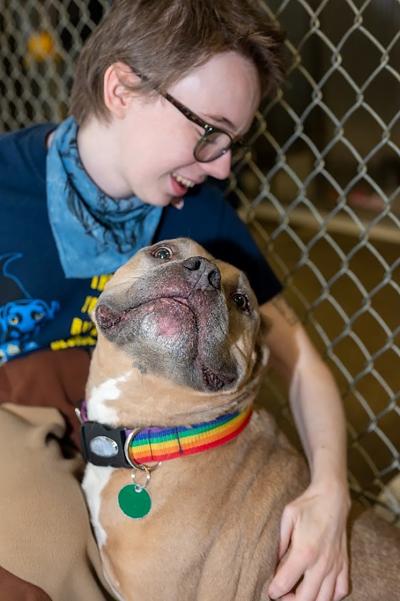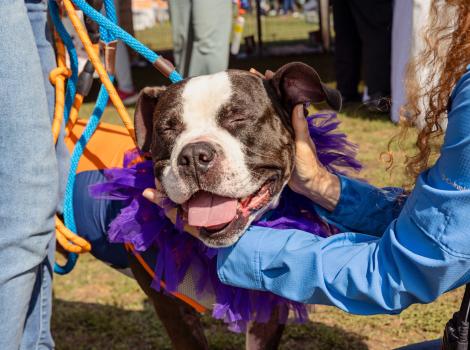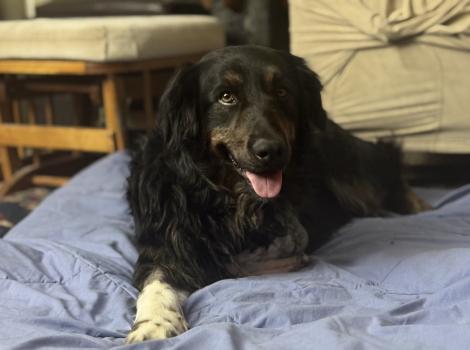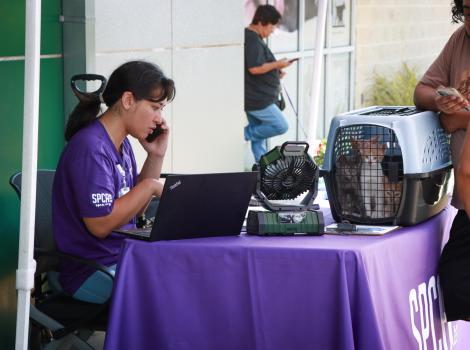A determined voice of change for homeless pets

Teresa LaCross has a way of speaking that is uniquely hers. When she’s talking with her shelter’s board, it goes like this: “Listen, we need a computer system, so we can start tracking the animals we take in, and we need it before January 1.” And when there were protesters outside the shelter back in 2016, it went like this: “Listen, if we start making changes to do better, the protesters will stop.”
When Teresa speaks to her staff, she says, “Listen, the very first thing I want you to do when a new animal arrives is to say out loud in the room, ‘How will we save this one?’” In other words, she doesn’t mince words, and she doesn’t mess around. It’s all about one word: listen.
Teresa’s story is centered at Michigan Anti-Cruelty Society (MACS), a shelter that takes in about 5,000 animals a year in Detroit. Her story — and ultimately the animals’ story — matters because, for decades, more dogs and cats were killed than were saved at the shelter. MACS operated the way that most shelters did back in the era when around 17 million pets were killed in U.S. shelters every year. Even with a dedicated staff (some of whom have been at MACS since the 1970s and who work there because they genuinely love animals), the shelter was stuck.
Teresa began as a volunteer in 1996 because she is one of those people — she loves animals. In 2000, she was hired to answer phones. Back then, she wasn’t pushing people to listen. Not yet. “It wasn’t really a safe shelter in the past,” Teresa says. “I thought, what can I do to change this? If I keep my mouth shut long enough, will I get in far enough that I can make a difference?” She could have moved on and worked somewhere else, which would have been understandable, especially if she had known that some extremely difficult times were ahead. Instead, she chose to stay. And when she found her voice and made it so loud that it couldn’t be ignored, everything changed. People listened.

Pressure from protesters
If Teresa was a quiet presence inside the shelter, biding her time until she would be heard, she had some unlikely allies in the community. People were fed up, angry that pets were being killed at MACS, and around 2016, they started holding protests outside the shelter. By that time, Teresa had worked her way up to co-manager at the shelter. She was finally in a position to change things, and, at the same time, she was at a loss about what to do.
“People were out there every day screaming and also bashing us on the internet,” Teresa recalls. “It was a nightmare — the names I was called.” So she invited them in. Come inside, she told the protesters, and I will show you why we’re having such a hard time. She showed them that every single cage was full and that more animals were coming in. “Help me,” Teresa said. “Can you take any of these animals home?” It worked at least once, but the reality was that MACS needed systemic changes from top to bottom, and guidance on how to make those changes, because while it can be simple, it’s not necessarily easy.
[Shelters get creative to showcase adoptable pets]
It was the loud voices in the community that pushed Teresa to go to the shelter’s board and implore them to listen. The board let her go to an animal welfare conference to learn what MACS needed to do to save more lives. That first step outside of MACS and into an environment filled with other professionals was both eye-opening and overwhelming. “They were throwing so many things at me all at once,” Teresa remembers. But the next step became clear: MACS needed real data. The shelter had never had a computer system, and it was time to change that. Teresa told the shelter’s board: “This computer is going to tell me what we took in and how many we put down. We have to do this.”
Getting a computer system up and running made it possible to look at MACS’ actual data for the first time ever, and they didn’t like what they saw. “Our numbers were very bleak,” Teresa says. Collecting the data, however, did give Teresa real numbers to back up what she had been feeling all along. Those numbers would support her voice for change. It was time to take the next step.

Embracing changes
Meanwhile, Stacy Rogers, Best Friends central region director, had been reaching out to Teresa for some time about giving MACS a full shelter assessment to help the staff take those next steps. “We saw that they had a significant lifesaving gap, and those are the organizations we want to work with,” Stacy says. “So I began checking in, just seeing if they wanted any of the various services that we offer.” Armed with information and determination, Teresa said yes.
To educate herself further, she went to more conferences and then enrolled in a program offered by Best Friends and Southern Utah University to earn a certificate in animal services executive leadership. In the six-month course, she learned how to look at her shelter’s data to see which types of pets were most at risk. At MACS, it was cats. The shelter’s board had always been against trap-neuter-vaccinate-return (TNVR), but, Teresa explains, “I said, listen, I need to try this. We have to try something different.” She asked the shelter’s board to let her try what was needed to save more lives.
Teresa also got the green light to have the shelter assessment done. A team from Best Friends went to MACS to do a deep dive with Teresa, so she could make changes right away, especially for cats. Stacy says, “We worked on a whole lifesaving plan with them and showed them what to do next, and what to do after that.” The Best Friends team collaborated with MACS staff on increasing adoptions and growing their foster program. Stacy and several other Best Friends staff spent a lot of time in Detroit coaching the team at MACS and demonstrating what worked well in similar shelters.
[A well-rounded approach to saving more dogs and cats]
Teresa and her team eagerly did the work to implement the changes, and Stacy saw their determination. During one visit, she told them that they really needed a separate housing area for kittens to keep them healthy. She left Detroit on a Thursday, and when she spoke with Teresa the following Monday, Teresa said, “My husband’s here and we’re building a kitten room upstairs in an old office.” They rearranged everything and had the kitten ward set up in no time. They meant business!
More Best Friends people went to Detroit to give MACS on-site training in community cat programming, talking through how to handle calls about free-roaming cats. MACS has a clinic and a veterinarian on staff — an invaluable resource — so Stacy coached them on how to change their system to save more cats. They started reserving vet appointments in the schedule every day for community cats and spaying or neutering, vaccinating, and returning those cats to their neighborhood homes rather than admitting them to the shelter, where they are statistically unlikely to make it out alive.
All of this — Teresa’s feelings and determination from the very beginning, the public outcry, the assistance and information offered and acted upon — have led to where MACS is today. Previously, they had never saved a community cat or transferred an animal to another organization, and now they’re doing both. They’ve won grants to sponsor cat adoption fees, support their community cat program, and fund veterinary care for dogs instead of taking them into the shelter. And Teresa is now the executive director.
The people at MACS have so much to be proud of. In 2023, MACS saved 1,000 more cats than they did in 2022. That makes MACS one of the top 10 most improved shelters in the entire country.

Chloe: 1 in 1,000
One particular kitten is a symbol of what’s possible at MACS today. The call came just before closing time: Someone had found a black kitten with plastic zip ties around each of her front legs. Teresa asked the veterinarian to stay a little longer and said yes to the kitten coming in. “I didn’t realize at first how bad it was,” Teresa says. But one look at the kitten and it was clear it was an emergency. Her paws were swollen to double their natural size.
“In the past, cats would come like that and then they’d be gone. We would just put them to sleep,” Teresa says. “Our mindset back then was that it’s better than being on the street, better than being in some of these homes.” Instead, the vet sedated the kitten and gently removed the ties, cleaned her injured legs, and got her settled and comfortable. They named her Chloe. “She turned out to be the nicest little kitten,” Teresa says. They found her a home with someone who works at a vet clinic and was thrilled to adopt her.
There’s more work to do, of course, but now the team is in a better place to keep making changes to save more animals like Chloe. “MACS has a lot of the same staff they’ve always had, and they’re trying hard to change the things they have done for the last 50 years — literally,” Stacy says. “They are proof that with enough determination, you can make big changes. You don’t need a brand-new building or a whole new team.”
Teresa says, “We’re just gonna keep trying. We did so well with cats, and we can do better for the dogs now. We’ve got to figure that out and keep pushing forward.”
Meanwhile, the protests outside the shelter have stopped. They aren’t needed anymore because the loudest voice for change is coming from inside the shelter.

This article was originally published in the September/October 2024 issue of Best Friends magazine. Want more good news? Become a member and get stories like this six times a year.
Let's make every shelter and every community no-kill in 2025
Our goal at Best Friends is to support all animal shelters in the U.S. in reaching no-kill in 2025. No-kill means saving every dog and cat in a shelter who can be saved, accounting for community safety and good quality of life for pets.
Shelter staff can’t do it alone. Saving animals in shelters is everyone’s responsibility, and it takes support and participation from the community. No-kill is possible when we work together thoughtfully, honestly, and collaboratively.







